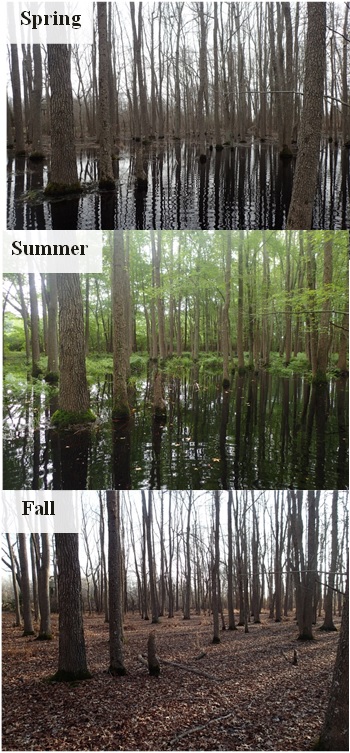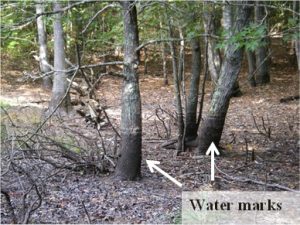
Facebook Twitter Instagram YouTube RSS Feed
Written on: May 18th, 2018 in Wetland Assessments
by Erin Dorset, DNREC Wetland Monitoring and Assessment Program

Figure 1. From top to bottom: spring, summer, and fall at a long-term monitoring site in Ted Harvey State Wildlife Area.
Are wetlands always wet?
In some ways, wetlands are self-explanatory: lands that are wet. But oftentimes, it’s not so simple. Some wetlands are wet for the entire year and always have water on the surface or are very damp. Those wetlands are pretty easy to identify. However, some wetlands are actually dry on the surface for a lot of the year, and only have water on the surface during wet seasons, like spring. Such seasonal freshwater wetlands are common in Delaware, and include wetland types such as forested flats, wet meadows, and Coastal Plain Ponds.
These types of wetlands are extremely important for wildlife. Yet, they are the most vulnerable to loss and degradation from human impacts. Part of this vulnerability stems from general misunderstanding; if these wetlands are seen during a dry season, people may not know that they are actually wetlands and should be protected and preserved because of the important services that they provide. Even though they are dry on the surface for part of the year, they are still wetlands!
What do seasonal freshwater wetlands look like?
The forested flat pictured here (Figure 1) is one example of a seasonal freshwater wetland. It is located within Ted Harvey State Wildlife Area, and is at one of WMAP’s long-term monitoring sites. The 3 photos shown here (Figure 1) are all taken from the exact same spot in the wetland.
However, they all look drastically different. This shows you just how dynamic a single wetland can be, changing so much throughout the course of a year! The wetland usually has water on the surface several inches deep in the spring time because of snow melt and rain. In the summer, the wetland may or may not have water on the surface, depending on how much precipitation has fallen. It is very common in the fall for the flat to completely lack surface water and appear dry.

Figure 2. This Coastal Plain Seasonal Pond was dry on the surface when the photo was taken, but the water marks on the trees show that it has water on the surface for part of the year. Photo credit: Bill McAvoy.
You might now be wondering: how can you tell if an area is a wetland when there is no water on the surface? Luckily, nature leaves behind many clues. If you know what to look for, you can be a wetland detective! Here are just some of the common signs that an area that may appear dry when you first see it is actually a wetland:
• Water marks (Figure 2) and moss on the bases of tree trunks
• Blackened leaves on the forest floor
• Wetland plants growing in the area
• Water near the surface in the soil
As illustrated in Figure 1, it is always a good idea to see an area during different seasons to understand the complete picture. To learn more about different kinds of seasonal freshwater wetlands and what they look like, click here!